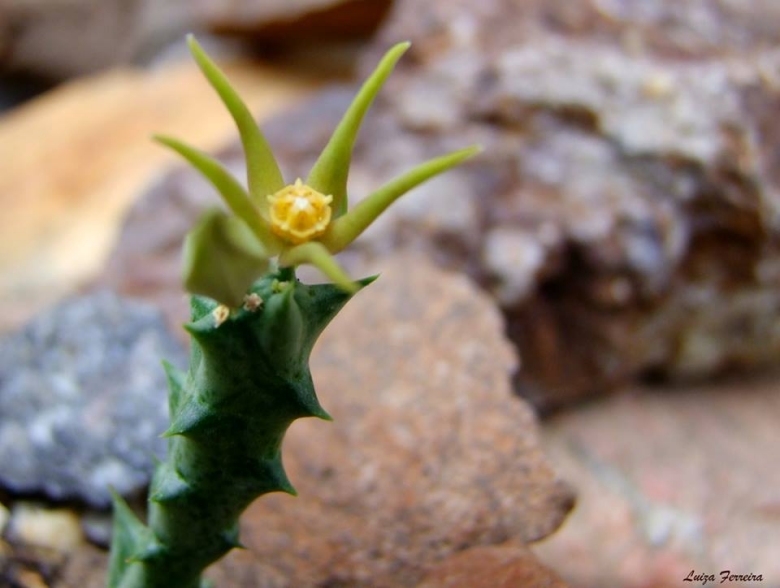= Orbea wissmannii var. parviloba Bruyns
Aloe 37(4): 76. 2000
Accepted Scientific Name: Orbea wissmannii (O.Schwartz) Bruyns
Aloe 37(4): 76. 2000

Angolluma parviloba (Orbea wissmannii var. parviloba) Photo by: Luiza Ferreira
Origin and Habitat: Yemen.
Synonyms:
See all synonyms of Orbea wissmannii
back
Accepted name in llifle Database:Orbea wissmannii (O.Schwartz) BruynsAloe 37(4): 76. 2000Synonymy: 16
back
Description: Orbea wissmanniiSN|796]]SN|796]] subsp. parviloba is similar to subsp. wissmannii but has thinner corolla lobes.
Distinguishing features: The corolla lobes are inside yellow, yellow suffused with red, or red and yellow. The corona is yellow (sometime tinged with red), with outer lobes forming a pouch. The pedicels is 5-10 mm long. The corolla lobes are 9-10 mm long and less than 2 mm wide (more than 3 mm wide in subsp. wissmannii), pale yellow and are covered with white hairs. The corona is 1.5-2 mm tall and 2.5 mm across.
Subspecies, varieties, forms and cultivars of plants belonging to the Orbea wissmannii group
 Caralluma meintjesiana Lavranos: (= Orbea wissmannii) Flowers are fleshy stars with 5 narrow, linear lobes, mostly light green with a blood red centre but very variable. Distribution: Saudi Arabia, Yemen, Oman.
Caralluma meintjesiana Lavranos: (= Orbea wissmannii) Flowers are fleshy stars with 5 narrow, linear lobes, mostly light green with a blood red centre but very variable. Distribution: Saudi Arabia, Yemen, Oman.  Orbea wissmannii (O.Schwartz) Bruyns: Corolla lobes 12-20 mm long and more than 3 mm wide, strongly curved to touch each other behind lobe and lobes convex adaxially; yellow more or less suffused with red or red becoming paler toward apex, glabrous or covered with short papillae; corona 3-4 mm tall x 3-4 mm in diameter.
Orbea wissmannii (O.Schwartz) Bruyns: Corolla lobes 12-20 mm long and more than 3 mm wide, strongly curved to touch each other behind lobe and lobes convex adaxially; yellow more or less suffused with red or red becoming paler toward apex, glabrous or covered with short papillae; corona 3-4 mm tall x 3-4 mm in diameter.- Orbea wissmannii var. eremastrum (O.Schwartz) Bruyns: Corolla lobes 12-20 mm long and more than 3 mm wide, slightly folded back and lobes lightly convex adaxially; yellow suffused with red (sometime flesh-coloured) in proximal half, greenish yellow to yellow towards tip, glabrous or covered with short papillae; corona 3-4 mm tall x 3-4 mm in diameter.
 Orbea wissmannii var. parviloba Bruyns: Corolla lobes 9-10 mm long and less than 2 mm wide, pale yellow, covered with white hairs. Corona 1.5-2 mm tall,2.5 mm in diameter. Distribution: Yemen.
Orbea wissmannii var. parviloba Bruyns: Corolla lobes 9-10 mm long and less than 2 mm wide, pale yellow, covered with white hairs. Corona 1.5-2 mm tall,2.5 mm in diameter. Distribution: Yemen.
Bibliography: 1) Bruyns, P.V. 1000. “New combinations in the genus Orbea.” Aloe 37(4): 71-76.
2) Bruyns, P.V. 2.002. “Monograph of Orbea and Ballyanthus (Apocynaceae-Asclepidoideae-Ceropegiae).” Syst. Bot. Monographs 63: 1-196.
3) Collenatte, S. 1999. “Wildflowers of Saudi Arabia.” National Commission for Wildlife Conservation and Development (NCWCD). Kingdom of Saui Arabia.
4) Meve, U. 2.009a. "Taxonomic changes in Arabian taxa of Orbea Haw. (Ceropegiae)". Asklepios 105: 19-11.
5) Meve, U. wo9b. "Correction: Orbea nardii precedes Orbea wissmannii var. parviloba." Asklepios io6: 12..
6) Miller, A.G., Morris, M. 1988. "Plants of Dhofar." The Office of The Adviser for Conservation of the Environ-ment, Diwan of Royal Court. Sultanate of Oman.
7) Mosti S., Raffaelli M. “Re-evaluation of Orbea nardii and 0. wissmannii var. parviloba, including infraspecific reclassification of 0. wissmannii” Asklepios 110/2011
8) Pilbeam, J. 2010. “Stapeliads.” British Cactus & Succulent Society. UK.
9) Plowes, D. 2.010. “When is a Caralluma not a Caralluma?” Asklepios 107: 3-2.2.
10) Raffaelli, M., Mosti, S., Tardelli, M. 2.008. "Apocynaceae of Oman : Orbea nardii, sp. nov. and Pentatropis bentii, first finding." Webbia 63(1): 161-167.
11) John Hunter Thomas "Systematic Botany Monographs" American Society of Plant Taxonomists, 2002
Cultivation and Propagation: Orbea wismannii var. parviloba is an easy blooming plant when mature that require moderately watering through the growing season but enjoy plenty of water and some fertiliser in hot weather, this helps them to flower freely. Water more sparingly in winter according to temperatures. But, as with most asclepiads, it is unwise to leave them wet in cold weather. Winter care presents no problems at 5°C with plenty of light. Since roots are quite shallow, use a cactus mix or add extra perlite or pumice to regular soil potting soil. A gritty, very free-draining compost is suitable, and clay pots help the plants to dry out between watering.
Sun Exposure: Partial sun or light shade
Pest and diseases: Orbeas vary in their susceptibility to rotting, but are generally fairly easy to grow, especially if kept pest-free. They are very susceptible to stem and root mealy bugs, and damage from these may well initiate fungal attack. If you do have problems with a stem or with basal rotting, you can reliably isolate the healthy parts, dry them off, and re-root them in moist compost.
Cultural Practices: Re-pot every 2 years
Propagation: Easiest with stem cuttings. Allow cuttings to dry a day before planting. Stems must be laid (Not buried) on gritty compost and will then root from the underside of the stems. It can also be increased from seeds sowing in spring in moist, sandy peat moss.
Potting medium: Since roots are quite shallow, use a cactus mix or add extra perlite or pumice to regular soil potting soil. A gritty, very free-draining compost is suitable, and clay pots help the plants to dry out between watering.










